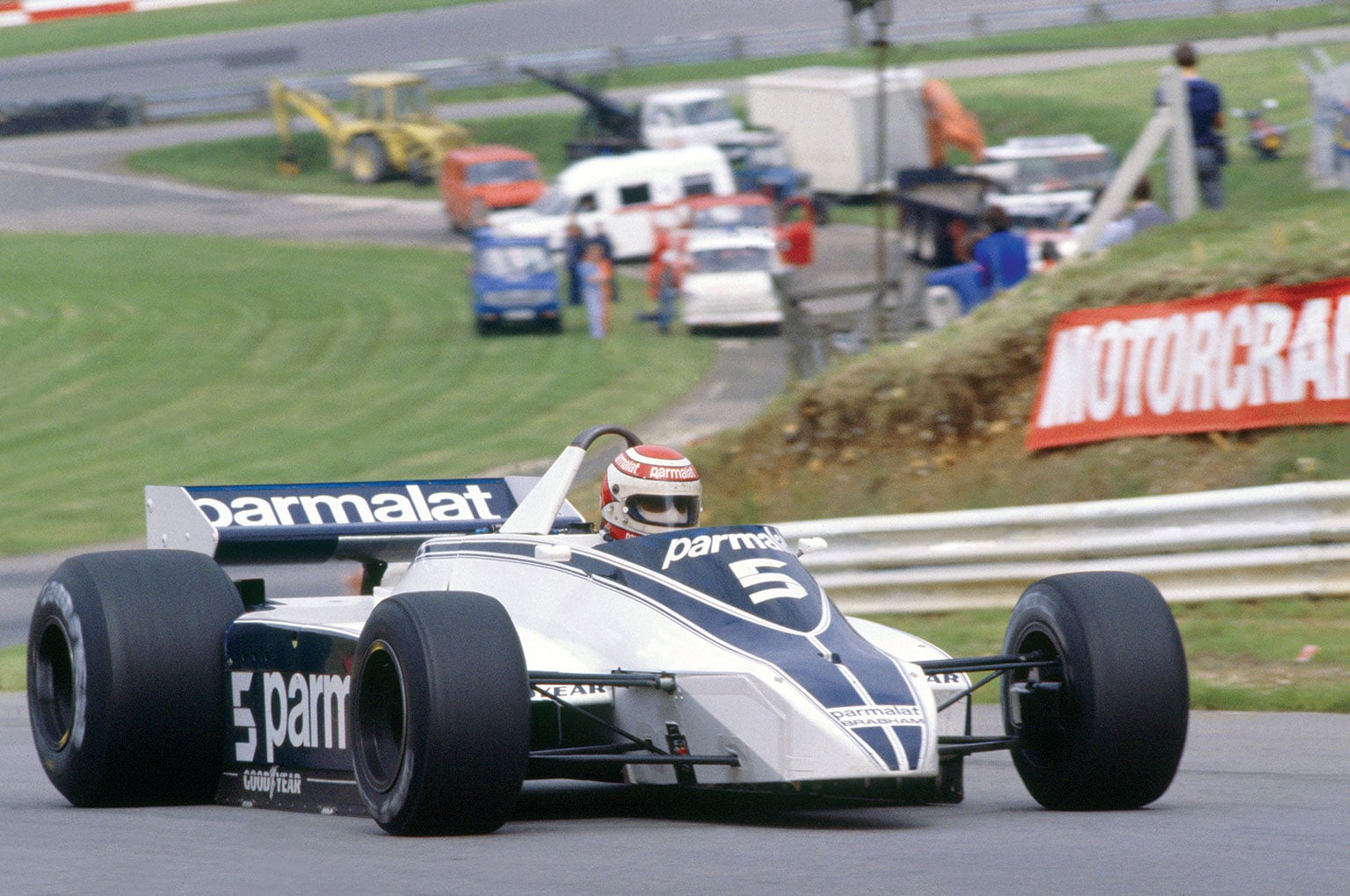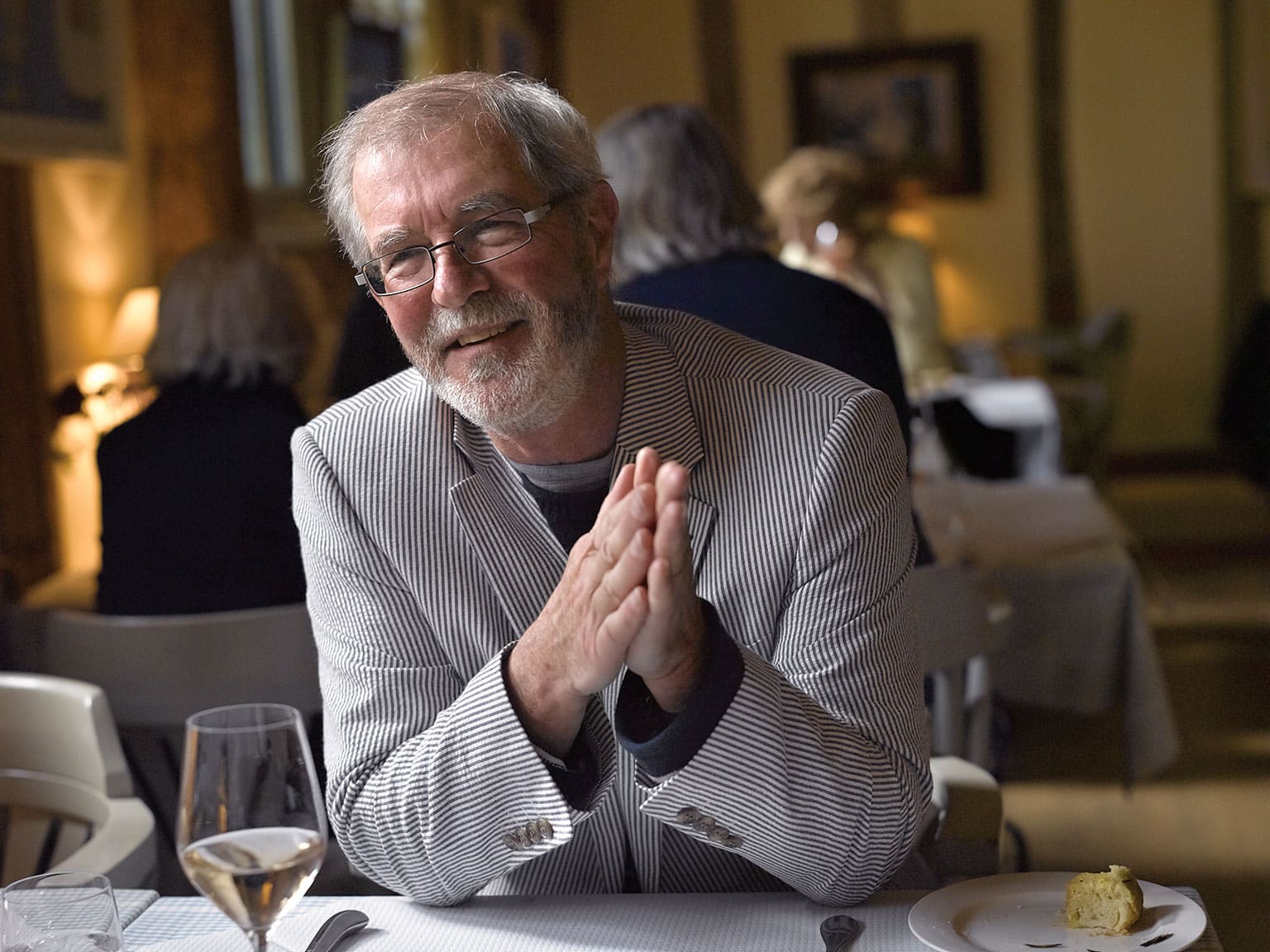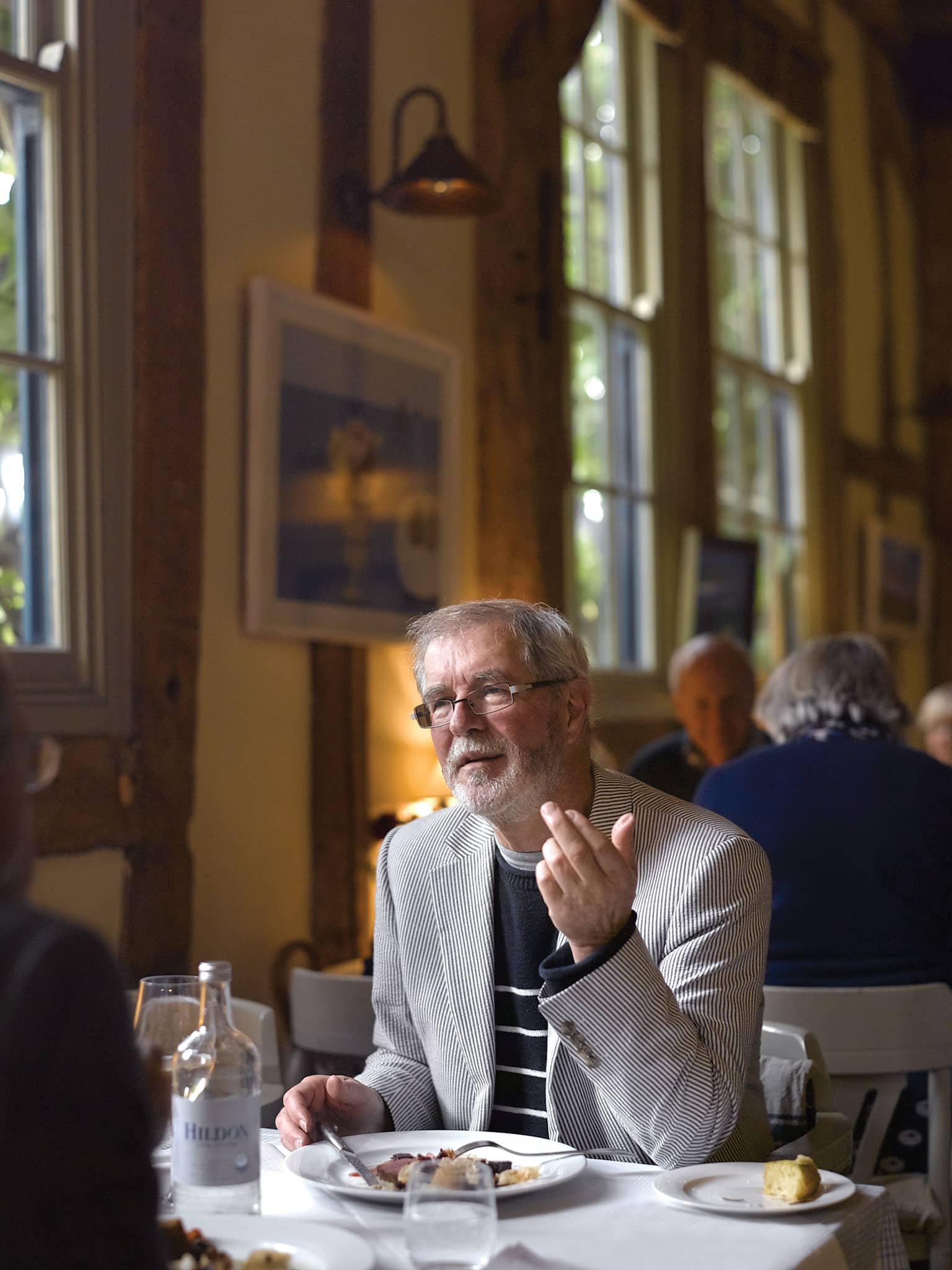Lunch with... Peter Stevens
Widely respected for his work in all spheres of automotive design, he drives a tractor and a Citroën 2CV van... among other things
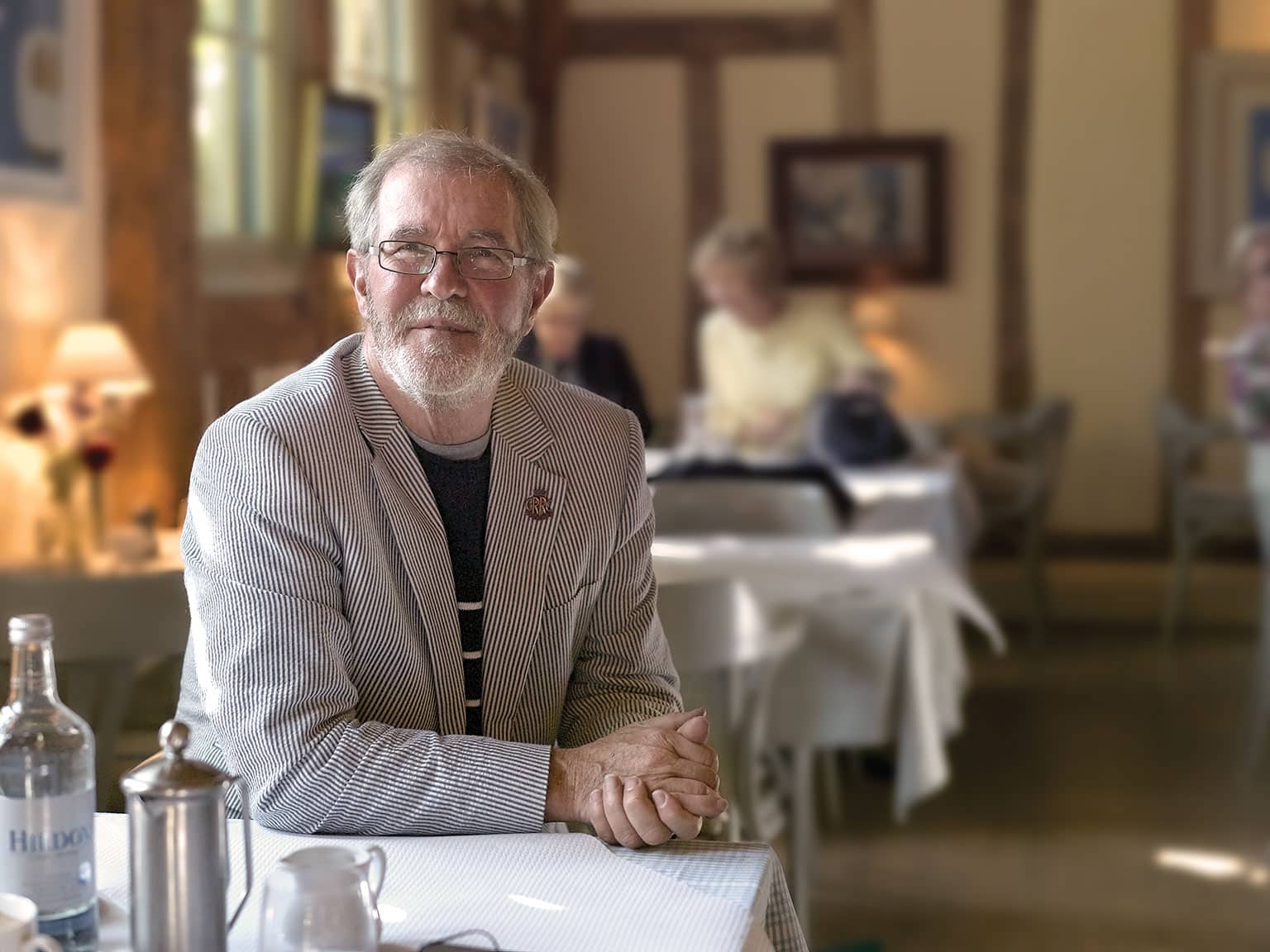
James Mitchell
Spend time with Professor Peter Stevens, and you learn a cornerstone of his philosophy: there should be as much satisfaction in designing something humble and workaday as in designing something high-profile and glamorous. For both, the criteria are the same: each must do what is required of it as well as possible, and with functional elegance. As he says: “There is nothing that can’t be better for being better designed.”
A lifelong enthusiast for all things automotive, Peter has built up a reputation over the past half-century as a hugely versatile car stylist and designer. His road car projects have run the gamut from supercars to econoboxes to trucks. His work with Gordon Murray on the original McLaren F1 is perhaps his best known, but he has also been responsible for motor cars as varied as the Lamborghini Jota and the Reliant Kitten. Meanwhile his fascination with motor sport, and the need to seek what Mark Donohue called the unfair advantage, have repeatedly directed his mental energy towards finding ways to make racing cars more efficient.
Yet one of the designs that gives him the most pride is the Mahindra Gio, a tiny single-cylinder pick-up truck which has enabled huge numbers of people in rural India to afford for the first time a vehicle that will help them earn a living. And away from cars altogether, he has come up with things like a carbon fibre pod for premature babies. “It’s cushioned and insulated, with provision for oxygen, drip and monitor, and because it’s carbon you can x-ray right through it, without taking the baby out of the pod.”
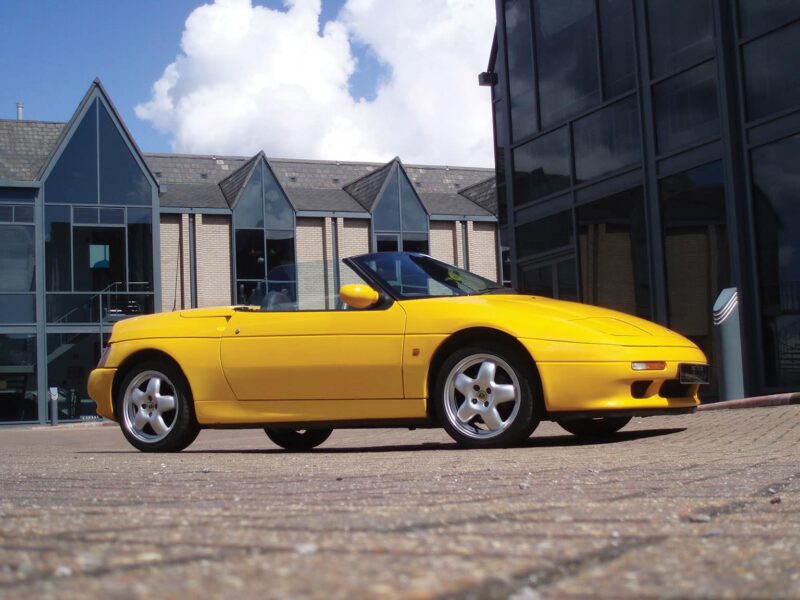
Stevens was closely involved with front-drive Lotus Elan
Unsurprisingly, Peter’s personal drives are eclectic. His transport to the village shop from his Suffolk home may be his 1950s grey Ferguson TE20 tractor, or his Citroën 2CV van: “One of those little crinkly boxes with a very short rear overhang.” He has two early Model A Fords, a roadster pick-up and a 1928 hot-rod that wears a Model T body to save weight. He arrives for lunch in his Fiat 500, apparently standard except it rides lower, has wider wheels and has its engine cover slightly open à la Abarth. We’re at the Leaping Hare at Stanton, adjoining the seven-acre Wyken Vineyards. It has been judged one of Britain’s 100 best restaurants and rates a mention in the Guide Michelin, and our game terrine and venison with beetroot tarte tatin does not contradict this. It’s helped on its way by a bottle of Wyken’s own Bacchus dry white.
Peter was born in 1943, and both his parents were artists. “My father was actually a very good painter, but he couldn’t support a family on that, so he taught at St Martin’s School of Art. At school I was good at art, and I liked woodwork too: proper honest woodwork, which now is called something fatuous like ‘resistant materials’. Our woodwork teacher taught us common sense: measure twice, cut once, that sort of thing. For O-level I did pure maths, applied maths, physics, art and woodwork – not because I thought they’d be the right qualifications to be a designer, but just because they were the subjects I liked most.
“I was always fascinated by cars, and there was one great influence on me from an early age. My uncle, my mother’s brother, was Jenks.” Denis Jenkinson was racing passenger to Eric Oliver, world sidecar champion, and was also at the beginning of his lifelong career as Continental Correspondent of Motor Sport. “He had a kind of workshop in the basement of our house, and he’d sleep there. During the racing season he’d come home to get his washing done. He had loads of Meccano, and he taught me to use it and helped me make things. When I was about seven we built a simple Meccano gearbox together, and it worked, with the cogs sliding on the shafts.
“Jenks was one of five children: he was the youngest, my mother was next. She was small of stature, just as he was, and I’ve got a picture of them together as school kids, looking like a couple of little angels. Around the turn of the last century their dad, my grandfather, worked for Bill Morris in Oxford building bicycles, and then the first Morris cars.
“We didn’t have any money to speak of, so I had to make my bicycle out of scrap bits I’d found, frame, handlebars, wheels, and save up for the tyres. When I was 16 I sold it for £10 and for not much more I got an M-type MG.
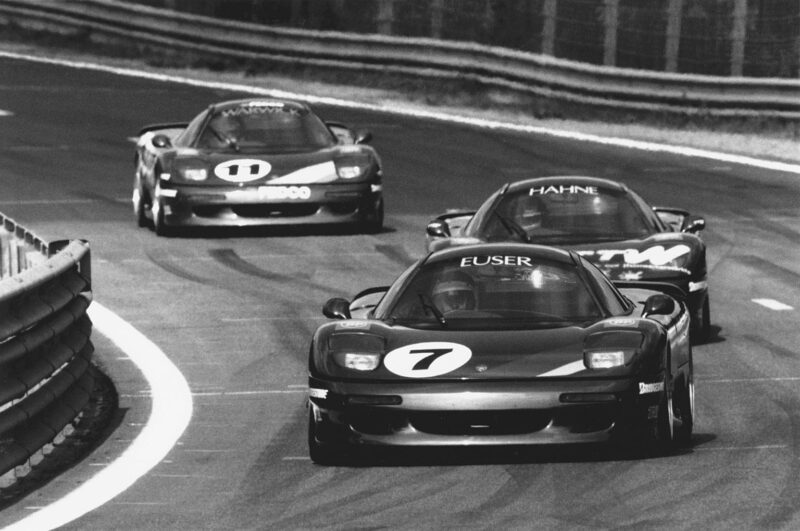
Jaguar’s XJR-15 was based on XJR-9 running gear and spawned a one-make series
Motorsport Images
“I booked my driving test for a few days after my 17th birthday in Cambridge, and I couldn’t get anybody to accompany me there from my home in North London, so I took off the L-plates and drove there alone, put the L-plates back on and took the test. It was pouring with rain and the MG had no hood, but the examiner thought it was great fun. Afterwards he said, ‘Where’s the friend you came up with?’ I said, ‘Umm, he’s in the caff around the corner.’ He said, ‘There is no caff around the corner. It’s just as well you’ve passed.’
“From school I went to St Martin’s, and then to the Royal College of Art. My project for my bachelor’s degree was a little 50cc racing motorbike, and when I’d built it I competed in sprints with Jenks, him on his 500, me on my 50. In the long vacation a friend of mine, Donald Anderson, and I pooled our funds, all of £120, and drove a 1942 Jeep 14,000 miles to Timbuktu, Libya, across by ship to Beirut, Petra, Damascus and back. We’d chosen a moment when various wars had either just finished or not quite started. I drove every yard of the way: Donald had sublime confidence that I knew what I was doing, and he was only interested in finding a local source for a good joint.
“At the time Ford of Britain didn’t have a formalised way of training young designers, so they asked the RCA to start a post-graduate two-year Master’s degree in vehicle design. A friend of mine, Dawson Sellar, and I were picked as the first two students and we pretty much invented how the course should work.
“Ford paid us £1200 a year, a lot of money to us in 1968, enough for me to buy an Abarth 750 double-bubble coupé. Part of the deal was that we joined Ford after the course, and I was there nearly four years. I did various bits and pieces, like the awful Capri front end with the square headlights, which I wasn’t pleased with at all. Then I did the later one with four headlights under eyebrows, which was better. I did stuff on the Transit van, the Granada fascia, that folding winder for Ford’s sunshine roof.

MG ZT-T estate topped 225mph at Bonneville
“After Ford I was offered a place at Porsche – Dawson was already there, working on a projected mid-engined replacement for the Beetle – but the ex-pat thing didn’t appeal to me, so I went to Ogle three days a week and taught at the RCA two days a week. I worked on the Kitten, the four-wheel version of the Robin, and the Rogue, which was a vaguely sporty version. Then we built a rough prototype of a weird mid-engined Reliant with twin-cam BRM head and chain drive from the gearbox to the rigid rear axle.
“In 1976 I optimistically set myself up as Peter Stevens Design. One lesson I’d learned at Ford was how to structure a project. You needed a budget, and you needed a timeframe. If you stuck to those two things, you’d get a client to come back again. Some of my clients I kept for a long time: I did ERF trucks for 14 years.
“An early client was Alpine. I got very friendly with their rally guys, particularly Bernard Darniche. We’d go to lunch at a place just outside Dieppe, opposite-locking back to the factory in the rain, and Bernard would say, ‘Peter, you must design for us a wiper on the side window.’ I was involved in the Renault 5 Alpine, and then I did an open two-seat sports car which, when Renault bought the majority shareholding in Alpine, became the Renault Spider.
“I’d done some racing car graphics already, bits for Richard Lloyd and for Guy Edwards. When I read that Brabham had a new sponsor, Parmalat, I phoned the factory and asked to speak to Mr Ecclestone. They put me through: he didn’t know me from Adam, but I said I’d like to propose some livery for his car. He just said, ‘Be here in two hours.’
“When I got there he took me into the workshop and there was the BT46, painted in a scheme proposed by Parmalat. It looked like a fairground ride, yellow, dark green, light green, gold, light blue, dark blue. Niki [Lauda] came in and said, ‘Bernie, what the f**k is this? This car looks like shit, and I’m not driving a car that looks like shit.’ Bernie said, ‘It’s all right, Niki, this is Peter, he’ll have some drawings for us by the morning.’ Then he looked at me and said, ‘They’d better be good.’
“I spent all night on it, and Bernie liked it. They still had the Alfa engine, so the car had to be red, but when Alfa quit we went to white and dark blue. Bernie had a startlingly good eye, but he didn’t waste time on anything. If I showed him six proposals he’d say: ‘Why are you showing me six things when I only want one? Are you trying to prove you’ve been working hard? Don’t think I’ll pay you any more money if you show me all this stuff.’
“But he really cared about the detail. He’d come on the phone and say, ‘Gordon’s got these refuelling churns, and they look like beer barrels. Do something about it.’ So we had them sandblasted and anodised blue. Or the drivers’ overalls: ‘They look a mess. And that Piquet, he’s a mucky bastard, he pisses in his suit during the race.’ So we got the overalls tidied up. One day I walk in and he says, ‘Oi, you’ve had your hair cut. Where did you have it done?’ Then he bellows at his secretary: ‘Book me in, 5 o’clock, Peter’ll tell you where.’
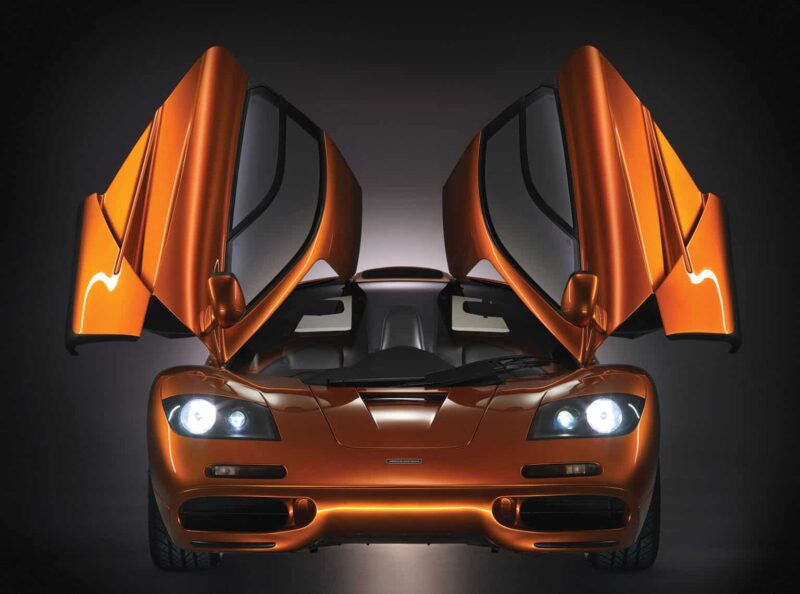
McLaren F1 was supposed to be just a road car…
“Bernie will always out-flank you. The pub he used to go to, there was a table where he always sat, and nobody else was allowed to sit at Bernie’s table. Then the landlord decided he wanted to do dinners, but there were local objections and he couldn’t get the necessary permission. So Bernie bought the pub. The council still wouldn’t give permission, so he said, ‘Fine, I’ll turn it into a fish ’n chip shop. With lots of big bright neon signs.’ It’s like at Spa, somebody wanted to knock down that black and white building at La Source. So Bernie bought it, to stop them. Then somebody at Monaco wanted to knock down the Rascasse, so he bought that too.
“What he really likes to do is take the piss. At F1 races, when he can see the McLaren motorhome across the paddock from the FOCA motorhome with Ron Dennis entertaining sponsors, he’ll get out his mobile and send Ron saucy texts and watch his face when he reads them. At the same time he can be unbelievably generous. After that massive 2004 tsunami he sent, not money – ‘give money to charity, and you can never be sure where it’s going’ – but schools: prefabricated buildings to allow kids who had lost everything to have somewhere to go to be educated. One day he asked me to go and look at a village church near where I live in Suffolk. His father, who’d worked on fishing trawlers, came from there, and he’d sent £120,000 to the local vicar because the church needed a new roof. He wanted me to see whether the money had actually gone on the roof. I checked, and it had.”
When Colin Chapman died at the end of 1982 Lotus had been working on an affordable sports car, a modern Elan. Work progressed slowly, and then engineering director Colin Spooner brought in Peter to do freelance work on the project. “But when General Motors bought into Lotus they told Spooner that Lotus had to have a proper design department. He called me and said, ‘Either you come and set something up, or they’re going to impose something on us.’ So I moved up to Norwich, set up in a Portakabin, got myself a couple of pattern makers and a couple of clay modellers. Then I hired Julian Thompson, who’s with Jaguar today, and Simon Cox, who now runs the Nissan Design Europe studio.” The result was the Isuzu-engined front-drive Elan M100, of which nearly 4000 were built.
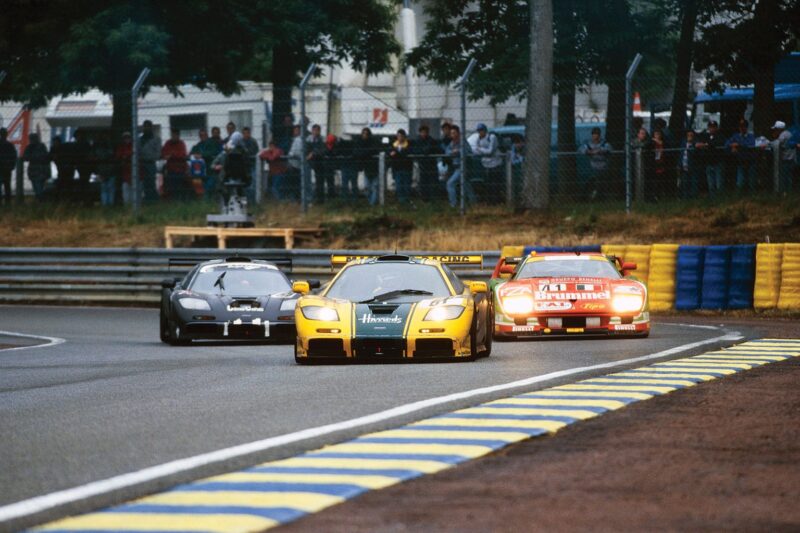
…But a race version soon followed. Bell/Bell/Wallace took third at Le Mans in 1995
Motorsport Images
“I was with Lotus full-time for about five years. As well as the M100 we revised the Esprit, we did the Excel, and we did other project work for General Motors, like the Cadillac LSS, a projected light sports saloon. And Lotus was quite happy for me to moonlight at weekends for Richard Lloyd Racing, developing the team’s Porsche 962.
“For that, which Richard called the 962GTi, Nigel Stroud designed a completely different monocoque, and we did a lot of work in the MIRA wind-tunnel. Once you get in the tunnel you can see what you’ve got, and discover how to get the same results using less energy. Plus, as well as less drag, you can find more stability. The works Porsches had slots in the tunnels underneath to take out the cooling air blown over the cylinder heads by the fans. At Brabham I’d learned from Gordon Murray that even the smallest hole can wreck the downforce. So we closed those slots and made a little gurney that sucked the cooling air out of the back of the car. We changed the ducting to the intercooler, and we mounted the rear wing differently.” Some of these changes later found their way onto the works cars.
“We also found that completely covering the rear wheels gave loads more overall downforce. But other drivers found that, in the traffic jam at the start, if they gave our car a sharp nudge on the rear corner it popped off the wheel cover, probably broke the latches, and the extra downforce was gone.
“Most people don’t realise that downforce doesn’t just earn you cornering speed: it radically improves braking. Jan Lammers, when he first drove the Porsche, said: ‘When I approach a corner at 200mph it doesn’t matter how hard I hit the brakes, I could push them with both feet, and the wheels won’t lock. There’s so much downforce that the wheels keep on gripping. But at lower speeds, like coming into the chicane, you haven’t got the downforce and I have to come off the brakes to unlock the wheels.’
“I first got involved with Tom Walkinshaw doing the body kit for the racing Mazda RX-7, which won him the 1981 Spa 24 Hours. If you can improve the aerodynamics of a car and make it look better at the same time, you get an advantage all round. I worked on the TWR Rovers, the BMWs, pretty much anything Tom was racing, and we got on extremely well.
“Nobody got up earlier in the morning than Tom. He’d see things that everybody else missed. Like the big refuelling tanks in the pits at Le Mans: he worked out that the further down the pit lane you were, the higher the pressure in the fuel hoses and therefore the quicker your refuelling stops. So while the posh teams got themselves allocated the pits at the top, he’d go down the slope to the other end.
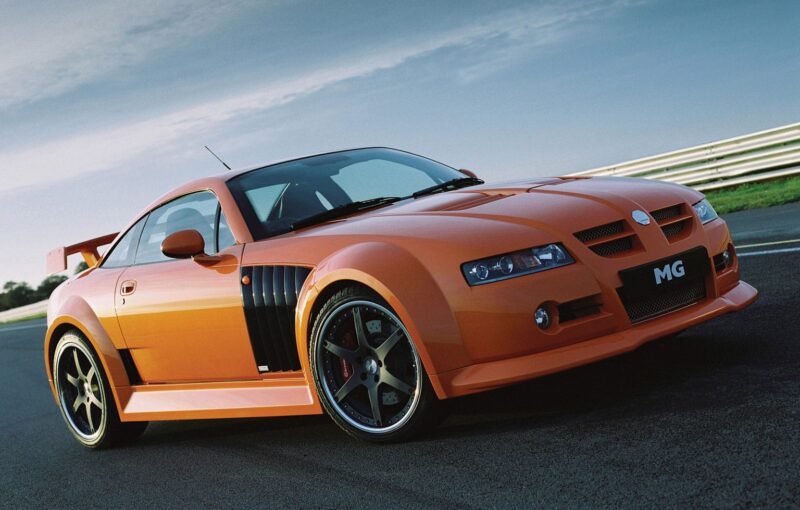
When MG bought Qvale, Stevens used the Italian firm’s Mangusta design as basis for the SV
“When Tom’s businesses fell over it destroyed him, really. The F1 thing went wrong, TWR went into receivership, everything went horrible and he was a broken man. Maybe that brought on his cancer. He’d made some stupid decisions. But the Jaguar XJR15 wasn’t one of them.
“When Jaguar first showed the XJ220 at the 1988 Birmingham Motor Show, Tom and I looked at it and he said: ‘What a monstrous ugly car!’ It was so big, just horrible. It had been put together by an unpaid Saturday Club of Jaguar people, and it was shrouded in dishonesty because the launch spec said it was four-wheel-drive, and it never could have been. And of course it ended up not as a V12 but a V6 turbo. It was Tom’s dismay at the 220 that started him off on a road-going version of the XJR-9, which he called the R9R before it became the XJR-15. I widened the cockpit, raised the roofline and gave it its own shape, and it was ready by the summer of 1990. It was a riot to drive, and it made a beautiful noise. Then Sir John Egan gave the 220 project to Tom, so now we had both: the 12-cylinder XJR-15, and the 220 with that cement mixer engine.
“In the end 53 XJR-15s were built. We’d always intended it purely for the road, but Jaguar wanted the 220 to be seen as a road car, so they asked if the 15 could be presented as
a racer. To underline this they funded a race series, with three rounds supporting the Grands Prix at Monaco, Spa and Silverstone, and a $1 million prize. It was terrific racing, 16 identical thundering six-litre cars with some very good drivers. The series included free Bridgestone tyres that were very tall in profile, and Tony Southgate, who’d designed the XJR-9, wasn’t happy because at the last minute Tom wouldn’t fund a different gearbox casing on which the rear suspension was mounted. So the XJR-15 oversteered. But as long as you didn’t lift off mid-corner it was all right.”
Peter was winding up his role in the XJR-15 project when he had a call from Gordon Murray, who’d left Brabham for McLaren a couple of years before. “We had dinner, and he told me – which I’d already heard – that he’d talked Ron into making a road car. He wanted my advice on how to set about finding a designer for what he called ‘the styling bit of it.’ I said, ‘You’ve already found him.’
“There were several enormously strong points about working with Gordon. First, he had Ron’s absolute trust and confidence, and was able to persuade the board to spend the money. Gordon had the idea of the centre-seat three-seater right from the start, but Ron thought this ultimate road car should be a single-seater. Gordon’s response was: ‘Well, you may not have any friends, Ron, but most of our customers will.’

Richard Lloyd Racing Porsche 962 with Stevens-inspired wheel covers
Motorsport Images
“One of the first things we did was make a seating buck so we could see what it would be like to ride in, the driver in the middle, a passenger each side, slightly behind. Ron, Gordon and [TAG boss and McLaren shareholder] Mansour Ojjeh, all fairly tall people, sat in it, and it was fine. Ron’s first comment was: ‘The driver can see his passengers’ shoes!’ – typical Ron – but we explained that in the real car with the bodywork, and the driver looking where he was going, it wouldn’t be like that.
“Another thing about Gordon is that he always questions the rules, and the accepted ways of working. Like Colin Chapman, he believes rules aren’t made for him, they’re just there to stop ordinary people getting in a muddle. He’d decided on a weight limit of 1000kg, and that’s what it was going to be. So he told Kenwood they had 14kg for the whole hi-fi system, and to hit that spec they had to develop aluminium speaker magnets.
“The F1 started with a clean sheet of paper. We didn’t put ourselves in any category: we wanted to make the F1 absolutely as good as we could, but we took no notice of what the opposition were doing, we went our own way. At one stage we did borrow Nick Mason’s Ferrari F40 and it was mostly rather awful. And I drove a Lamborghini Countach down from Suffolk in pouring rain, and it was a dreadful thing. All it told me – not that I needed telling – was that our car had to demist properly.
“For the first year I didn’t draw anything, I was purely involved with the packaging and the ergonomics. I was bursting to draw stuff, but at that point we didn’t have an engine. We looked at a number of potential suppliers. Gordon always wanted a V12, which is long, and that meant we needed a short gearbox.
“Once we knew what I had to clothe I made a quarter-scale model, and I only defined the cockpit area, because we knew where the people would be, and the windscreen. Then I made a series of front and rear ends that I took to the wind tunnel. The drag coefficient had to be good, and it had to be stable. Gordon and I agreed that we didn’t want to cover it with spoilers. I spent a lot of time in the tunnel. We only wanted about 100lb of downforce at 100mph, because that’s 400lb at 200mph, and with much more than that you’d need springs like a truck. What you really want is a centre of downforce that doesn’t dance up and down.
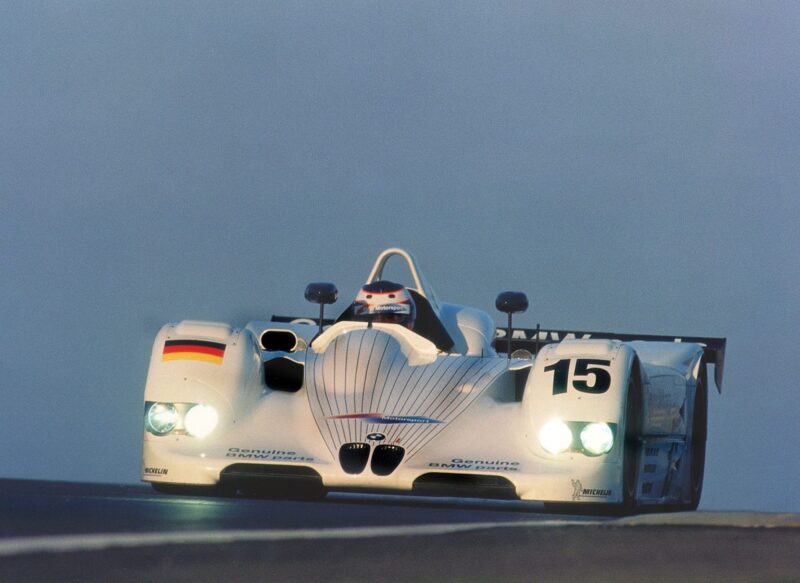
BMW won Le Mans with V12 LMR in 1999
Motorsport Images
“Working with Gordon was pretty harmonious because he had very good reasons in engineering terms for where everything should be, and it was up to both of us to make the packaging work. I said we didn’t want a great long tail because it would add more weight and it wouldn’t look good. He’d say: ‘Can I get my silencer in? It’s 640 litres.’ So I’d say, ‘OK, I’ll make sure there’s room for that.’
“The F1 was in every way purely a road car. The project was all done and I’d moved on when pressure from customers persuaded McLaren to produce a racing version, the GTR. Thomas Bscher was one of these, and he took his to Dave Price, whom I’d worked with before on endurance racing projects.
“Pricey’s aim is always to beat the factory, and I knew things about the F1 that weren’t going to make it an ideal race car. The chassis stiffness behind the cockpit wasn’t as good as in front: the engine and gearbox were soft-mounted, so we made up a sub-frame at the back to stiffen it up. And we re-ducted the radiators, to get the holes at the front smaller.
“The long tail was done by somebody else, using the Brabham wind tunnel. I’d used that tunnel on another project, and I knew the hotter it got, the better the results. If you stopped a while to change something the tunnel would cool down, but if you made the change quickly it would stay hot. That gave you major inconsistencies. So the long tail was no faster. Plus it looked like a donkey.”
In that 1995 Le Mans one of the two Dave Price Racing cars, the Harrods-sponsored GTR driven by Bells Derek and Justin and Andy Wallace, led the race until it was hobbled by a weak clutch withdrawal bearing, a problem on all the McLarens. “We discovered it on the Wednesday, and [team engineer] John Piper and I spent Thursday and Friday rushing all over northern France trying to find a suitable replacement, without success. Sure enough late in the race it failed. Andy chugged out of the pits for his last three-hour stint with the car in fourth gear, didn’t use the clutch until the end. He did a brilliant job, so did Derek with the same procedure, and we finished third. If that hadn’t happened Derek would have got his sixth Le Mans victory, at the age of 53.
“But the real result that season was that Thomas and Nielsen did the 12-round European GT series, won two rounds, were consistent all season, and won the title.”
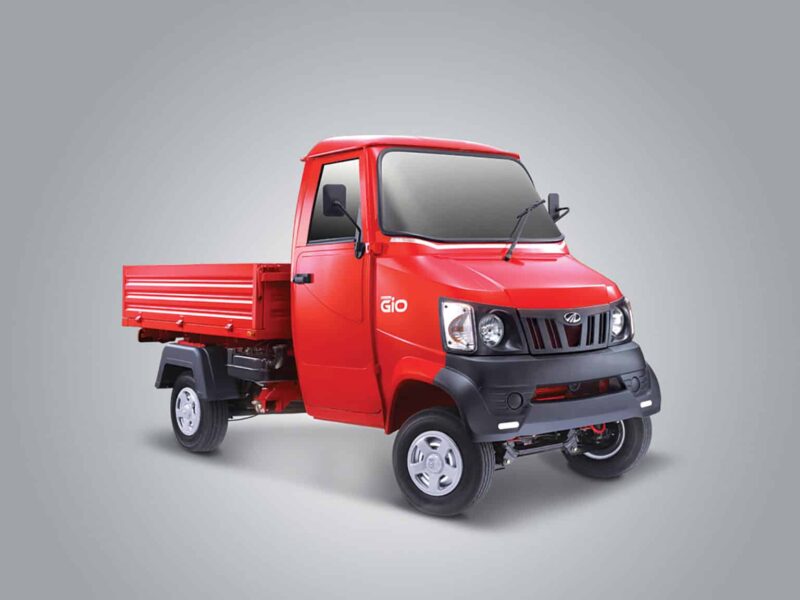
At opposite end of the spectrum, the Mahindra Gio
A further Le Mans involvement was with the 1999 BMW. “Williams built BMW’s 1998 car and Patrick Head, by his own admission, was fully occupied with the F1 programme and hadn’t paid much attention to it. When he saw the front suspension, he expressed his views in typically strident terms: ‘Look at that geometry! By the time the bloody damper knows the wheel is going up it’s bloody coming down again.’
“So for 1999 the whole car was radically rethought. Karl-Heinz Kalbfell from BMW came to me late in 1998 and asked me to do what he called ‘the white bits.’ He was a lovely bloke. He died at Brands Hatch a couple of years ago, racing one of his historic bikes.
“I got a desk at Williams, and it was all finished by New Year’s Eve. My task was to make it look good and have BMW design values, and still have the right aerodynamics. Patrick said: ‘This is a racing car. What do we need a bloody stylist for?’ So I said, ‘I’ll make you a deal: anything that I propose which is as good in the wind tunnel as what you’ve got already, or better, we’ll do.’ I’d been told that you had to take a lot of self-confidence to Williams, because you’d get none from Patrick.
“But much to his delight my shape came out of the wind tunnel better: the frontal area was lower. I loved working with Patrick and those guys at Williams. And at Le Mans Jo Winkelhock, Yannick Dalmas and Pierluigi Martini beat all the Audis and Toyotas and AMG Mercedes, and won it.”
Then Peter got involved with Lamborghini. “I’d known Mike Kimberley when he was CEO at Lotus, and when he became Lambo MD he asked me to go down there. I wasn’t very popular at first: the guys there said, ‘How can an Englishman march in and tell us what a Lamborghini should be like?’ Well, I’ve always believed that a designer’s job is to learn and understand the culture of a car company, and then interpret that culture into a three-dimensional object. Some designers try to impose their culture on the company – like one famous designer who had a favourite wheel arch, and plonked that wheel arch on every car he shaped.
“I did the Jota, which was the version of the Diablo with twin scoops on the roof, and I made proposals for a Diablo replacement. Plus I drew a supercar that was to be called the L30, to celebrate 30 years of Lamborghini. But I had endless trouble finding somewhere decent to live, and whenever I went to collect my expenses they’d give me a thousand quid in 1000 lire (40p) notes in a shoe box, which was useless. You can’t do anything with that without looking like a criminal. By then Chrysler had sold the company to Indonesians, and it was never going to work, so I came home.
“I’d met a guy called Nick Stephenson at an industry dinner, and discovered we both liked drag racing and hot-rods, and we exchanged cards. In 2000 he phoned me up and said: ‘Do you want to do something really risky? Could be good, could be bad, but I’m in a four-man consortium that’s going to buy MG and Rover from BMW, and I want you to be design director.’
“I had a quiet word with the BMW chief, Bernd Pischetsrieder to see what he thought. He said, ‘OK, Peter, here’s what you do. Tell them you don’t want a job, you want a consultancy. Ask for a three-year contract, and say they have to pay you this much. And make sure they never owe you any money.’ In 2005, when it had all collapsed, I saw Pischetsrieder at the Geneva Show. ‘So, Peter, did you follow my rules?’ ‘Yes, all except the last one.’
“The Phoenix consortium bought the business from BMW for £10, and we worked wonders on no money at all. The entire design budget was £13 million a year, which doesn’t get you seat trims at BMW. We updated the MG F into the TF, we did the V8 version of the Rover 75, and we did the MG estate car that did 225mph on the Bonneville Salt Flats.
“Then there was the MG SV. That was MG Rover taking over the Mangusta, the former De Tomaso Bigua, from Bruce Qvale. At first they just wanted to slap an MG badge on the existing car, but I said ‘no way’. It was a nightmare to build and we wanted to develop it properly. Nick said, ‘What can you do for £10 million?’ I said I’d have a car that he could drive in 12 months.”
Front-engined, rear-wheel-drive, the SV had the Mangusta’s all-alloy four-cam 4.4-litre Ford V8, five-speed manual box and Brembo brakes. Bonded to the chassis was a hunky-looking body in carbonfibre. “We found some people in the Isle of Wight to make affordable carbon composite panels. All the suppliers did their bit, we assembled the cars in Italy and we got complete cars delivered to MG Rover just needing their interiors and instruments. We made 82 of them, at a retail price of between £65,000 and £85,000, before the whole of MG Rover collapsed. In the final months there were all sorts of negotiations with the Chinese, but in the end Shanghai just waited for it to fall over. It was such a shame. As Pischetsrieder said afterwards: ‘They weren’t crooks. They just weren’t good enough’.”
All this time Peter never stopped his consultancy work. His list of clients down the years is impressive and hugely varied, ranging at different times from Rolls-Royce to Tata, from Virgin Atlantic to Oz Wheels. “Bentley wanted a mid-engined proposal, and they built two chassis and tested one at MIRA. But the packaging was dreadful, and they were determined to have a Bentley radiator, and it wasn’t very good. For Don Panoz I did the road version of his front-engined GT racer, which was a fun little project. They only made one, and Don had it painted it in hideous purple and gold flip-flop paint, which was his idea of cool. I did livery for the Benetton F1 team – that was for David Richards, who wanted everything, including all the pit equipment, to look good – and I did work for Toyota on their GT-One Le Mans car. When Samsung was evaluating whether it should become a car manufacturer I did a soft-roader called Freetime, but it was never built. And before GM took over Lotus I worked on a sports car for Chrysler based on the S3 chassis, code-named Big Shot.
“Now I’m busy with a couple of very interesting projects, including an electric car for an American company. Tesla already has a very good product, so if you’re going electric you’ve got to be a step more efficient still. My vision is an ultra-aerodynamic, sexy four-seater, but I can’t tell you more. I’m also working on a project for a luxury car manufacturer, and I’m about to start on new tram cars for Sir Michael Kadoorie’s Hong Kong Peak Railway.
“But what matters most is education. If nothing else it’s an insurance policy for the future, because we need bright young people around to make our old age comfortable. As visiting professor at the RCA I’ve lectured on the history of car culture. There’s a saying in Arabic: ‘How do you know where you’re going if you don’t know where you’ve come from?’ The motor car is the most influential product of the last 100 years, and there’s virtually nowhere on the planet where it hasn’t transformed life.
“Designing cars means being able to create a car to meet any set of requirements. Young designers send me portfolios of their work every week, and it’s always Ferraris or Lamborghinis. So I say, ‘OK, now try a truck, now try an off-road ambulance.’ Wanting to design a Ferrari is not the same as wanting to design
a car to fulfil a specific need.”
Which is why Peter is being entirely honest when he says that the Mahindra Gio is as important to him as the McLaren F1. As he’ll point out, the former certainly changed more people’s lives, even if the latter was much more of an automotive icon. But both have played their role in the huge variety of this stimulating man’s working life. Today he’s still designing and, let’s hope, will still be for many years to come.
